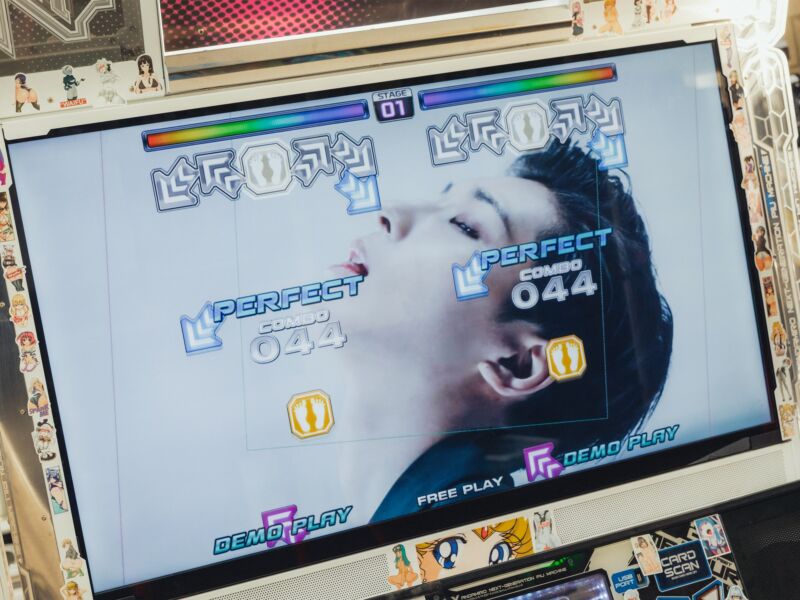
Last October, Phil Arrington precariously balanced a dream on the cargo bed of his 2002 Ford Ranger pickup. It was a stupid dream, but it did not deserve to die on a dolly behind a beige warehouse.
Arrington was hunched over the dolly, gold chain dangling over a tight gray tee. Between his arms, leaned at a 45-degree angle, was a video game arcade machine; its title, MUSECA, could be glimpsed over his shoulder. The machine had come a long way—from an arcade in Tokyo to an anonymous warehouse in Osaka and then, after a long wait on a container ship outside Long Beach, California, to Arrington’s warehouse in San Pedro. Arrington effortfully wheeled the 6-foot-tall cabinet toward the pickup’s hatch. On the concrete 3 feet below lay a thin, blue blanket. Nearby, a phone was recording.

Watching the video from across the country in Brooklyn, I screamed. It was my machine.

Arrington chose his moment to explain himself, and it was a couple of days later, live on Twitch, squatting in a red bucket, fishing out the dusty remnants from a half-empty bag of Flamin’ Hot Doritos. His tone was not contrite. He had intentionally cut the video at its most dramatic moment, he said. The machine was, in fact, intact. Arrington stood up, revealing athletic short-shorts, and, tossing the bag of Hot Doritos aside, made his way over to the Museca cabinet.
Museca was a glowing anime beacon. A neon red coil shot up through its base like a spine, supporting a console of five pastel-lit buttons, each the size of an adult hand. To the rhythm of a peppy beat, a player would press and spin these buttons at just the right time to amass points—that is, if the game worked. The cabinet, thankfully, had booted into a menu screen. “When you get something like this, you’ve got to take care of it. This is not like a Cadillac from the ’60s or ’70s, where people are making parts for it,” said Arrington. He pressed Start. The display went blank. “Oh shit,” he said. But then baby-voice pop music blared from the speakers. “Nevermind.”
These days, Museca is an extraordinary find, Arrington said. Like the other machines Arrington helps import, it’s primarily sold and played at arcades in Japan. On top of that, Museca’s publisher, Konami, discontinued the game a few years ago. The machines were recalled from across Japan, and their parts repurposed into an entirely new game called Bishi Bashi. Not many Museca cabinets survived, making them a particular prize for devoted fans of Japan’s storied arcade scene.
The country’s self-sizzling pleasure palaces have attracted millions of native and foreign otaku for decades, luring them in with the promise of competition and escape for the price of just one 100-yen coin. Taito Corporation’s Space Invaders marked the industry’s launch in 1978, and in the following years, Japan’s arcade scene blossomed, giving rise to classics like Donkey Kong, Contra, and Street Fighter II. Tens of thousands of arcades sprang up, packed tight with crane games filled with wide-eyed Pokemon plushies; greasy racing sims; shimmering fantasy role-playing or strategy games; scuffed-up fighting games; and of course, the full-body high of rhythm games like Konami’s Dance Dance Revolution or Museca.
Some titles, like DDR, got officially licensed or released overseas, where they’ve become cultural touchstones. But Konami, Taito, and other arcade game makers designed their best stuff exclusively for Japan, on idiosyncratic arcade hardware that was meant to stay there. “They don't want these machines to be sold outside Japan,” says Serkan Toto, CEO of Japanese consulting company Kantan Games. A lot of machines, including Museca, stipulate on their title screens that they are only meant to be played in Japan. In recent years, publishers like Konami have enforced this by ensuring their arcade games only function when networked to their proprietary server with a proprietary protocol.
The logistics and price of licensing is a big reason why—music, distribution, and payment. It’s also a commercial calculation, Toto adds. “The arcade machines are not stand-alone anymore—they have to be connected to a server, which makes maintaining them, controlling them, and operating them more complex. They don’t want the hassle of providing that knowledge and those maintenance services to companies outside Japan.” Lately, the Japanese arcade chain Round1 has installed locations across the US; but outside of that, the typical American has almost no access to the thousands of authentic arcade machines that brought glory to Japan as the holy land of gaming.
Today, though, Japan’s arcades are in crisis. Game centers are shuttering with heartbreaking rapidity, due in part to competition from home gaming consoles and a tax hike that raised the price of a single play. Between 2006 and 2016, the number of arcades deflated from 24,000 to 14,000. Covid accelerated this trend, emptying the arcades of regulars and tourists alike. Between October 1 and November 24, 2021, 20 arcades closed in Japan.
When arcades close, their video games face one of three fates, only two of which are sanctioned by a Japanese trade association of game manufacturers. The first is getting junked in a landfill. The second is getting gutted and sold for pieces, and then junked in a landfill. (Arrington calls this “the mafia treatment.”) Finally, the third: A Japanese distributor swoops in and buys up all of a dying arcade’s machines. Some get sent around Japan to smaller arcades. Others, on the down-low, are sourced to enterprising Westerners like Arrington, a self-described “muscle guy” for the gray-market entrepreneurs who import thousands of cabinets from Japan every year.
Over the last five years, as Japanese arcade machines have become more available than ever, Western demand for Japanese machines has exploded. To support that demand, an underground network of gamers has risen to the challenge of evacuating these cabinets from Japan, hauling them across the world, and hacking their code so fans like me can finally, after all these years, play.
reader comments
68